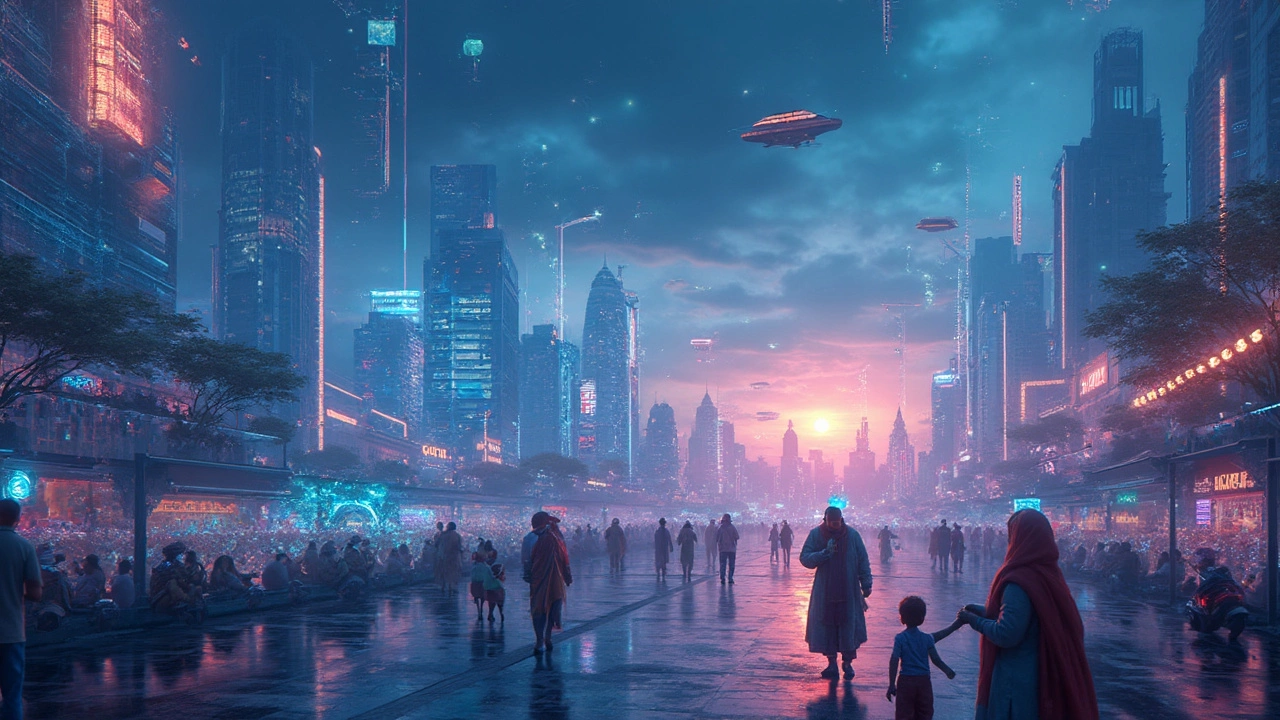Exploring Web 5.0: The Future of Web Development Frameworks
Web 5.0? Yep, that's already in the conversation, and it’s looking to shake things up in a big way. Imagine a web where the line between the real and digital blurs even further, where your online experience becomes as natural as chatting with the neighbor next door. Sounds exciting, right? But what exactly is Web 5.0, and why should you care?
Well, think of it as the next big leap in web development, bringing in new frameworks that promise to revolutionize how we interact with the internet. Remember when we couldn't imagine life without smartphone apps? Web 5.0 aims to create that kind of shift. It’s all about making things smarter, faster, and more intuitive. The buzz isn’t just about improving what we have but reimagining the entire web landscape.
Developers are looking at a future where web interfaces and intelligent systems work hand-in-hand like never before. The goal isn't just to create user-friendly sites—it's to craft experiences that seamlessly integrate into daily life. This means stepping up the game with AI and creating decentralized platforms that could redefine digital privacy and security.
- The Basics of Web Evolution
- Core Features of Web 5.0
- Impact on Technology and Society
- Future of Decentralized Apps
- Enhancing AI and User Experience
- The Shift in Internet Use
The Basics of Web Evolution
To get what Web 5.0 might bring, let’s zoom through the history of the web. We kicked things off with Web 1.0, known as the static web. Think of it as a giant brochure – information was there, but interaction was entirely one-sided. You'd go to a page, read the info, and that was it. No comments, no liking, no sharing, zilch.
Enter Web 2.0, which made the internet social. User-generated content became a thing, platforms like Facebook and YouTube blew up, and suddenly, we were all creators. It wasn't just about consuming content but also making it and interacting with others. Suddenly, the web was a two-way street.
Then we moved to Web 3.0, coined as the semantic web. This phase saw the push towards a more intelligent internet. It wanted to understand not just data, but its meaning, essentially aiming for a web that 'gets us'. In simple terms, it's why you see those eerily spot-on recommendations on your Netflix or Spotify.
Right on its heels, we saw the sprouting of Web 4.0, weaving more AI into the web fabric. This stage is still unfolding, with smart assistants like Alexa, Siri, and Google Assistant acting like your digital pals, ready to help 24/7, knowing your preferences better with each interaction.
Now, as we gear up to meet Web 5.0, the buzz is around creating an internet that's not just smart and interactive but offers experiences that are almost instinctive. We're talking about a web environment where tech bends even more to our needs, focusing on seamless integration into our lives, offering immersive and intuitive experiences.
Core Features of Web 5.0
Web 5.0 is on the horizon, promising to take our interaction with the internet to a whole new level. At the heart of this big leap is the fusion of the virtual and physical worlds, creating a seamless experience that feels almost lifelike. So, what's making this future tech tick?
First off, real-time data processing is a big player. Imagine interactions on the web that happen as quickly as a face-to-face conversation. This capability is powered by enhanced AI models and stronger computational resources—think of these as the brainpower behind all these snappy responses.
Another standout feature is hyper-personalization. With Web 5.0, your online experience will be molded to fit you like a glove. Thanks to advancements in AI, websites can anticipate your needs even before you know them yourself, offering content that's not just relevant, but almost telepathic.
Then there's the whole aspect of decentralization. This isn't just about data privacy; it's about empowering users. In a web development landscape that includes blockchain technologies, control over content and data truly sits in the users' hands. You’re not just browsing the web; you’re directly influencing it.
To top it off, there's augmented and virtual reality woven right into the web experience. Picture browsing a site, but instead of just reading text and viewing images, you’re stepping inside, almost touching and feeling the content. This sensory integration aims to create an internet not just seen and heard, but experienced.
In essence, Web 5.0 is gearing up to blend technology with human life like never before, making online experiences more intuitive, personal, and interactive. Developers will play a crucial role, using cutting-edge frameworks to craft this exciting future.
Impact on Technology and Society
So, what’s the big deal about Web 5.0 and how’s it going to change our world? Well, it's not just about cooler websites. It's an overhaul that could redefine tech norms and how we live our daily lives. Imagine a world where virtual meetings feel like in-person interactions or ordering groceries online doesn't just involve clicking, but involves a virtual walk through the store. That’s the direction we’re heading with Web 5.0.
This next-gen web is all about enhancing the virtual space with a sprinkle of reality. It's like having a personal assistant on steroids—integrating smart home tech, wearables, and more into an easily accessible digital ecosystem. This means not only more convenience but also more efficiency. Think of reduced commute times, less waiting in lines, and a streamlined way of managing routine tasks.
On the tech front, Web 5.0 promotes more straightforward interaction between diverse digital platforms, which could lead to new economic opportunities. Developers are already brainstorming ways to harness this to improve digital commerce, healthcare systems, and even education. Imagine AI-driven platforms that not only suggest learning resources but tailor entire courses based on your performance and interests.
The social implications are equally exciting. There’s potential for a more inclusive digital society where even those with limited access or disabilities can participate fully. With language barriers and physical limitations potentially minimized, Web 5.0 could advocate a more connected, global community.
The decentralization aspect is another game-changer, providing users with more control over their data. Security and privacy could take center stage, as the decentralized structure might limit data misuse. Imagine a web where your information isn't vulnerable to breaches every week.
But it’s not all sunshine and rainbows. As with any major tech leap, there are challenges around accessibility, the digital divide, and potential ethical concerns with more pervasive AI systems. While exact numbers are still being debated, some analysts predict significant job shifts as AI and automation become more prevalent, presenting both opportunities and hurdles society must navigate.

Future of Decentralized Apps
Alright, let’s dig into how Web 5.0 is set to transform decentralized apps, or dApps for short. If you're into Web 5.0 and what's coming next, you gotta pay attention to how these apps are evolving. Imagine apps where there’s no single point of control—meaning no snooping big tech companies or advertisers peeking in on your data. Sounds like a game-changer, right?
Decentralized apps are built on blockchain technology, which has already made waves with cryptocurrencies. But there's a shift happening where these dApps are expanding their influence beyond just digital coins. In Web 5.0, the aim is to make them as common as your favorite social media platform, but with more privacy and security.
Users can expect a future where dApps provide services like social networking, finance, and content sharing, all without the usual concerns about data breaches and privacy theft. The key difference? dApps put control back in the hands of users, not corporations. It's all about empowering individuals with choices and control over their information.
Here’s why this is exciting: developers are already exploring new development frameworks specifically for web development that cater to the unique needs of decentralized structures. These frameworks are designed to handle complex interactions across users without centralized servers. A cool fact? It's expected that by 2030, over 50% of all web services might be decentralized!
- Enhanced security and privacy for users.
- Democratization of online services.
- Opportunities for new, creative business models that reward users directly.
As web developers dive into this new realm, there’s a lot to consider—especially when it comes to ensuring that these decentralized solutions are as user-friendly and scalable as the apps we're used to today. The journey might be complex, but the potential for innovation and change is immense. Consider it as the web growing up, becoming more secure and much more personal.
Enhancing AI and User Experience
The talk of the town in Web 5.0 is how it plans to supercharge AI capabilities to create an internet experience that's as smooth as butter. Imagine AI not just minimal help but as a full-on co-pilot for our web journeys. We're talking about interfaces that adapt to your behavior, preferences, and even mood without you lifting a finger.
Here's where it gets wild: Web 5.0 is set to bring AI into the web development game, helping create websites that practically feel alive. Personalization is the name of the game, and we're expecting sites that tailor content to make every visit unique to the user. Can't find what you're looking for? Imagine an AI chiming in, guiding you like an old friend to exactly where you need to go.
With more intelligent AI tools, developers aim to enhance user experience by integrating seamless navigation, interactive elements, and personalized content curation. These web development frameworks will likely standardize elements like voice recognition and augmented reality to ensure consistency and accessibility, which, let's be honest, is a huge win for everyone.
And the technical magic behind it? Enhanced neural networks that utilize cloud power to deliver fast and accurate data processing. With the rise of decentralized apps, AI can leverage decentralized data to improve personalization while maintaining user privacy. So, AI isn’t just about flashy features; it’s a serious push towards making the web more inclusive and secure.
We're not just throwing out fancy features; Web 5.0 makes accessing complex apps through simple interfaces a reality for non-techies and tech enthusiasts alike. User experience will no longer be limited by device capabilities but bolstered by AI adaptation, ensuring that everyone gets an intuitive and accessible window into the expansive world of the internet.
The Shift in Internet Use
The way we use the internet is always evolving, but with Web 5.0, it’s about to get a whole lot more interesting. Picture a world where our interactions with the web are not just limited to screens but expand into the physical world, making our daily online activities more intuitive and immersive. This isn't just a sci-fi fantasy—Web 5.0 aims to make it a reality.
One of the biggest shifts we’re looking at is how personalization will leap to the next level. Right now, web algorithms suggest what to watch or buy next. But imagine these algorithms understanding the context of your environment—say, suggesting a coffee shop when you're feeling sluggish or offering driving directions based on real-time traffic, all seamlessly integrated into your digital world.
"Web 5.0 is not just an advancement of technology; it's a paradigm shift in human interaction with the digital world." — Dr. Sarah McKenzie, Web Futurist
With the advent of Web 5.0, decentralized apps (DApps) are set to become more mainstream. These applications run on peer-to-peer networks, offering more privacy and control over personal data. This shift could mean more secure and direct connections between users, cutting out the middleman and potentially reshaping how we interact with online platforms.
- Immediate benefits: Enhanced privacy and data control, thanks to decentralized structures.
- New possibilities: Greater integration of AI that truly 'gets' you and adapts to your needs.
- Global impact: Equitable internet access with localized data handling reducing latency and improving user engagement.
Furthermore, with more integration of the internet in physical spaces through IoT (Internet of Things), one can expect our environments to become 'smart'. Imagine your home adjusting its temperature as you approach or your office 'knowing' you’re coming in and adjusting lighting and resources accordingly. This seamless experience is a core promise of Web 5.0.
This new wave in internet use challenges us to rethink not just the 'how' and 'why' but the 'who' of the web—it’s not just developers and users anymore; it’s people and places becoming integral parts of the digital ecosystem.





